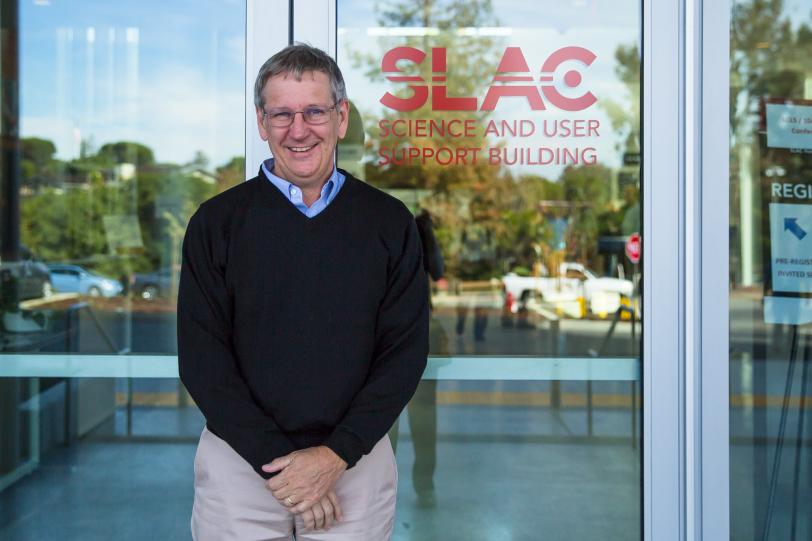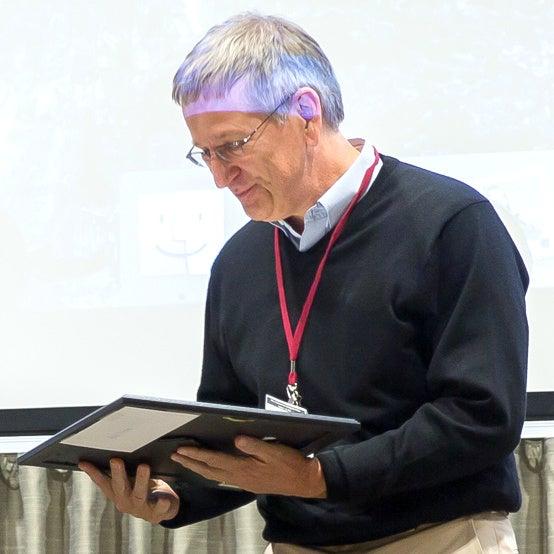Paul Fuoss Receives Lytle Award for Developing X-ray Technique to Better Explore Materials
Early Experiments at SLAC Led to Method Now Used Worldwide
Paul H. Fuoss has received the Farrel W. Lytle Award for developing a pioneering X-ray technique that is now used worldwide to explore the structure of complex materials. The award was presented during an Oct. 8 ceremony at the Department of Energy’s SLAC National Accelerator Laboratory.
A group leader in the Materials Science Division at Argonne National Laboratory, Fuoss had developed the technique known as “differential anomalous scattering” in experiments conducted on an earlier generation of SLAC's Stanford Synchrotron Radiation Lightsource (SSRL), which produces brilliant X-rays for a broad array of experiments..
Fuoss was a graduate student at Stanford University four decades ago when he began research at SLAC's X-ray source. The scattering technique became the focus of his PhD thesis under advisor Arthur I. “Artie” Bienenstock, professor emeritus at SLAC and Stanford and a former SSRL director. (Bienenstock was separately recognized during an Oct. 10 special symposium organized by SLAC and Stanford employees.)
The Lytle Award recognizes synchrotron-based scientific achievement and efforts to grow collaborations and make experiments more efficient. A former Boeing researcher who performed numerous experiments at SLAC during his career, Lytle made important contributions to X-ray science by developing a type of spectroscopy that is used to explore the structure of materials.
Fuoss had the opportunity to work in early X-ray studies at SLAC alongside Lytle, who is now retired and lives on a ranch in Nevada, "I've known him well since 1976," Fuoss said. "Farrel is one of the founding people in synchrotron science and it's great to get an award named for him. This was a surprise, and I'm honored."
Lytle could not attend the awards ceremony but sent a letter to congratulate Fuoss.
"I am particularly pleased when someone who I know well and admire receives the award," Lytle stated in his letter. He called Fuoss' technique "one of those 'I wish I had done that' examples" in X-ray science. "I recognized immediately the power and importance of the technique," he wrote.
Lytle and Fuoss both noted similarities in the respective X-ray techniques they helped to develop. While Lytle's technique, known as “extended X-ray absorption fine structure” or EXAFS, can be key in mapping the local atomic-scale structure around a particular element in a sample, Fuoss' technique can be used to explore the larger-scale structure and chemistry of a material.
"So it contains the 'longer-range' information, and that turns out to be really critical information for a lot of science applications," Fuoss said. As an example, he noted that the structural information it provides can be essential in unraveling how the material functions. "I'm really happy to see other people using this at synchrotrons around the world,” he added.
Fuoss continued to have an active research program at SSRL while employed at Bell Labs from 1980 to 1996. During that time, he developed techniques in grazing incidence diffraction, which is used to study the nanoscale structure of surfaces and layers in materials by hitting them with X-rays at a very slight angle from the surface. He used these techniques to perform real-time studies of the growth of semiconductor materials.
Fuoss has also taken part in experiments at another SLAC X-ray source, the Linac Coherent Light Source (LCLS), which produces X-rays about a billion times brighter than those produced by previous synchrotrons. LCLS and SSRL are DOE Office of Science User Facilities. He serves as chairman of an advisory committee for a planned upgrade to LCLS, and he had worked with an LCLS predecessor at SLAC known as the Sub-Picosecond Pulse Source that launched in 2003.
While at Bell Labs he also helped to design a handful of X-ray beamlines at National Synchrotron Light Source (NSLS) at Brookhaven National Laboratory, and at Argonne Lab his research group is a frequent user of the Advanced Photon Source, another synchrotron.
"I think synchrotrons have turned out to be a very powerful tool," Fuoss said, "and their evolution is quite phenomenal over the last 40 years. That was not so clear when I started. I don't think any of us would have predicted where it ended up."
Contact
For questions or comments, contact the SLAC Office of Communications at communications@slac.stanford.edu.
SLAC is a multi-program laboratory exploring frontier questions in photon science, astrophysics, particle physics and accelerator research. Located in Menlo Park, Calif., SLAC is operated by Stanford University for the U.S. Department of Energy's Office of Science.
SLAC National Accelerator Laboratory is supported by the Office of Science of the U.S. Department of Energy. The Office of Science is the single largest supporter of basic research in the physical sciences in the United States, and is working to address some of the most pressing challenges of our time. For more information, please visit science.energy.gov.







